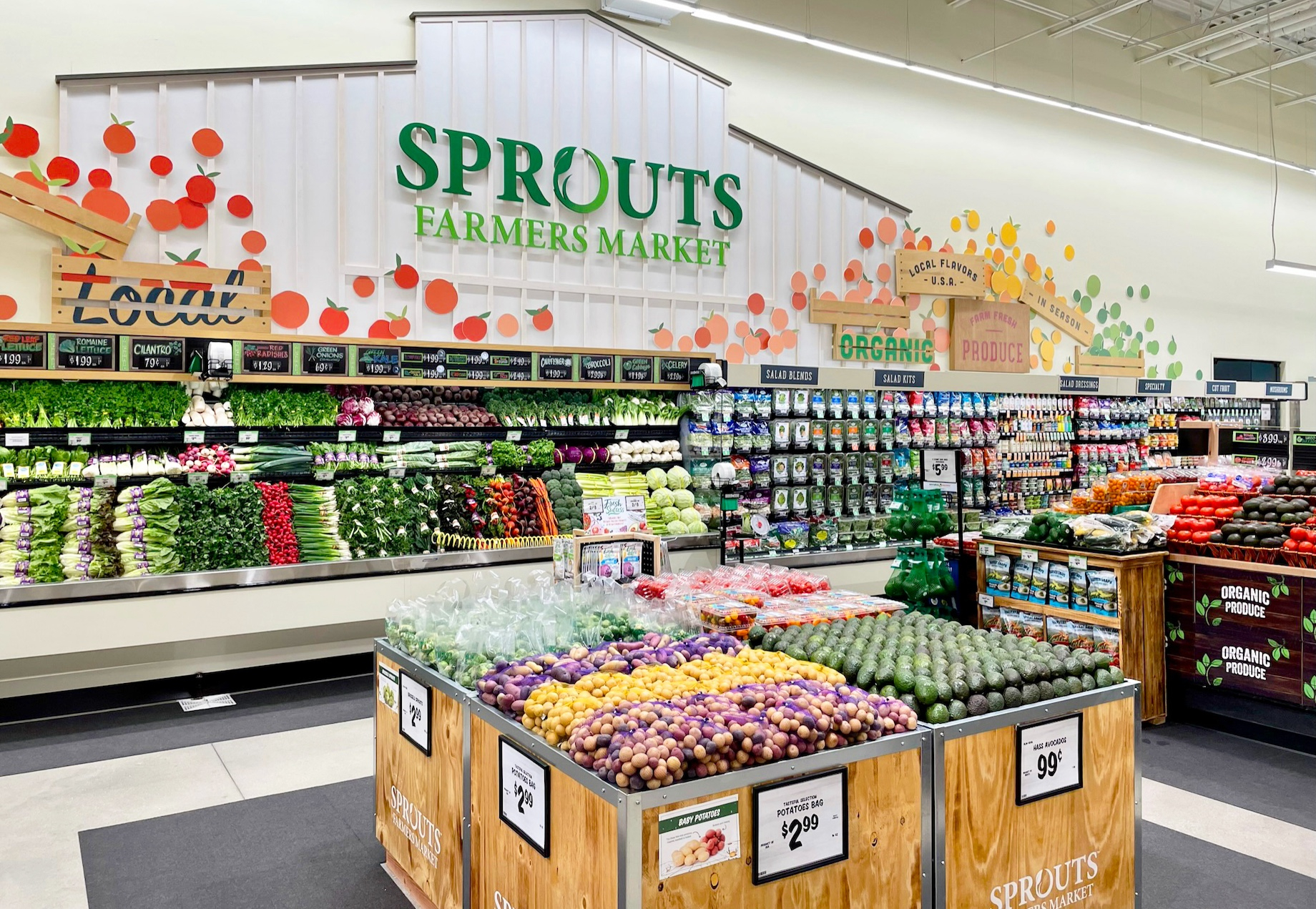Space for lease in grocery-anchored, mixed-use development with small shops, multifamily and office centrally located across the street from entertainment venue.
Sound like a desirable retail location? Don’t call the broker until you get a look at the property:

That’s Trajan’s Market in Rome — nearly 2,000 years ago. Anchored by a sprawling food marketplace, this “planned development,” completed in 110 A.D., included stores, an apartment block and multilevel offices for Emperor Trajan’s administration, not to mention a big entertainment amenity across the street, the Colosseum.
That’s how enduring the grocery trade has been. “Ancient plazas were the true origin of the supermarket,” said Sheri Blattel, retail design director for Cushing Terrell, an 86-year-old architecture and engineering firm. “As long as there has been civilization, fresh food has stood at the center of communities, and we are still putting groceries at the center of where we live today.”
Clarence Saunders opened the first Piggly Wiggly in Memphis, Tennessee, in 1916, trading out self-service baskets for the scrawled lists shoppers previously handed clerks. Former Kroger executive Michael Cullen launched what the Smithsonian Institution considers the first “true supermarket” in 1930, opening the first King Kullen in a 6,000-square-foot former commercial garage in Queens. His slogan: “Pile it high. Sell it low.” Some sources replace “low” with “cheap.” Other innovations included separated food departments, volume discount selling, loss leaders and spacious customer parking.

A Piggly Wiggly in Chicago’s Austin neighborhood in 1926. Source: Chicago Daily News negatives collection, Chicago Historical Society via Library of Congress
Through the rest of the 20th century, convenience-seeking populations dispersed to the suburbs, then the exurbs, then back to the urban core. And after nearly a century weathering such things as the Great Depression, World War II, convenience stores, dollar stores, online and omnichannel sales, the Great Recession and the COVID pandemic, the industry will post around $850 billion in sales this year, Statista estimated.
There’s little reason to believe grocery stores ever will be imperiled — even with online, omnichannel, c-stores, dollar stores and numerous other players staking market claims — said Terry Todd, associate principal for architecture, planning and interiors firm RDC. “Retail grocery is a staple of modern civilization. I think we were all reminded during the pandemic of how essential grocery stores are to the fabric of society.” Piggly Wiggly still has 503 stores from Texas to New York, and King Kullen still operates 27 stores on Long Island.
Ever indispensable, “grocery stores are recession proof in so many ways,” added Jeff Axtell, executive vice president of development for Vestar. “They attract a steady flow of foot traffic, which in turn supports other tenants at the property, and they provide a reliable and secure cash flow for investors.”
“As long as there has been civilization, fresh food has stood at the center of communities, and we are still putting groceries at the center of where we live today.”
Investment Picture
Despite traditionally slender profit margins, the grocery business remains attractive to investors, particularly specialty markets and expanding value chains, which are expanding in the West and other regions, Todd said. “Retail grocery has seen record profits from being an essential business, and they’re spending the windfall on construction.”
Dallas-Fort Worth is expected to lead U.S. markets in 2024 grocery store construction, as 14 grocery-anchored projects are underway or planned for 2024, according to Weitzman. Texas has more than 2.2 million square feet in grocery stores planned for the year, followed by Florida with 573,000 square feet and California with 342,900, according to Planned Retail.
And grocery stores also could spend construction budget on store refreshes and rebuilding projects.
“Retail grocery has seen record profits from being an essential business, and they’re spending the windfall on construction.”
Thus, grocery-anchored REIT stocks, called “REITS with eats,” are increasingly “getting snatched up by the institutions,” Altus Group senior market analyst Cole Perry said in a May Commercial Observer story. Investors continue to perceive them as recession-proof, high-foot-traffic assets, he said. “They’re easy to optimize, and they’re fairly standard in their format.”
Grocery-anchored REIT Kimco hit the 100 million-square-foot mark in early 2024, as it completed its purchase of RPT Realty and its 56 mostly grocery-anchored, open-air centers. Kimco’s first-quarter revenue grew 13.7% year over year. Regency Centers, in its first 2024 fiscal quarter, launched $80 million of development and redevelopment, dominated by the $67 million Shops at Stone Bridge in Cheshire, Connecticut, a ground-up, Whole Foods-anchored project in a master-planned community.
After J.P. Morgan Real Estate Income Trust bought 95% of the Shops at Grand Avenue in Queens, anchored by a 100,000-square-foot Stop & Shop, co-president Doug Schwartz remarked: “The neighborhood shopping center sector continues to be a bright spot in commercial real estate.”
“Grocery-anchored neighborhood shopping centers continue to benefit from macroeconomic trends that provide strong tailwinds for our company,” said Jeff Edison, CEO of Phillips Edison & Co., a large owner/operator of centers anchored by the likes of Kroger, Publix, Albertsons and Ahold Delhaize. Augmented by resilient consumers, Sun Belt migration and a need for last-mile delivery systems, “these trends are further amplified by high occupancy and the lack of new development over the last 10 years.”
Brick & Mortar’s Big Role Within Omnichannel
More than 80% of U.S. consumers prefer to buy their groceries at physical stores, according to a June Spar survey, and of those who do, 76% use mobile applications while shopping. In the U.S., annual supermarket and other grocery store sales will reach $846.4 billion in 2023, more than double the 1992 figure, and will eclipse $1 trillion in the not-too-distant future, according to Statista.
Even among online grocery shoppers, pick-up-in-store forms customers’ preferred last mile, according to U.S. eGrocery Market Forecast – 2024, which was developed by Brick Meets Click and sponsored by Mercatus. It determined that through 2028, online grocery sales are expected to grow three times faster than in-store sales and that pick-up-in-store orders are expected to grow 5.4%, compared with 4.4% for delivery and 2.8% for ship-to-home.
The advent of speedy grocery delivery created fear that shoppers would abandon physical stores, but that hasn’t happened, said Kenneth Katz, principal of retail real estate brokerage and development company Baker Katz. “Even people shopping online are still running to the store for last-minute goods, fresh items and for pharmacy and other services.” Todd added that online shopping will always have an inherent drawback: “How many people are comfortable with a shopping assistant selecting certain items who may not care as much about the marbling in a cut of meat as you or if an apple has a defect?”
Residential Demand and Smaller Formats
When people plan a move, access to groceries is one of the first questions they ask their agents. Witness the dozens of grocery stores sprouting up on the ground floors of urban and mixed-use multifamily buildings, often shrinking their footprints drastically for the chance to serve a built-in clientele.
Last year, for example, an 85,000-square-foot Wegmans opened in Brookfield Properties’ new Halley Rise apartment, office, retail and entertainment development in Reston, Virginia, complete with a restaurant section featuring a burger bar, sushi, pizza, subs and more. In January of this year, Meijer opened a small-format, 40,000-square-foot store at the base of the new Medley Apartments near Cleveland Clinic’s main campus in Cleveland’s Fairfax neighborhood, previously considered a food desert. Sprouts Farmers Market soon will open a compact, 24,740-square-foot Philadelphia store at the base of the new multi-use RiverMark Northern Liberties project on the Delaware River Waterfront, anchored by a 475-unit apartment tower, several media reports indicate. It will be part of a six-store Philadelphia market expansion.

Sprouts is opening 40 locations this year, and Regan Amato, executive vice president and manager of JLL’s Arizona retail platform, said most of its expansion will use the new, 23,000-square-foot prototype.
“Even in dense developments in the planning stages, we’re seeing retail grocery viewed as an amenity to the development,” Todd said. And for good reason. Apartment communities with anchor grocers enjoy an average rent premium of 6% above comparable communities in their immediate areas, according to May data from RCLCO, a real estate consultancy that tracks performance of grocery-anchored mixed-use centers.
To get as close as possible to residents in dense metro areas, Whole Foods Market will build stores as small as 7,000 square feet. Called Whole Foods Market Daily Shop, the first is under construction on Manhattan’s Upper East Side in a former Food Emporium at 1175 Third Ave. Additional New York City locations from 7,000 to 14,000 square feet will follow, as will a national rollout. Even traditional Whole Foods can go smaller. Whole Foods recently leased a 50,000-square-foot space in Scottsdale, Arizona’s Downtown East. That’s plenty of room for its typical 40,000-square-foot store, but Whole Foods said it will occupy 33,500 square feet and rent out the balance.
Enduring Locations
Regardless of size, enduring grocery locations can last decades. Fry’s had leased that Scottsdale space for 48 years, according to Western Retail Advisors, which represented Whole Foods in the deal. “If you have a good piece of real estate where a grocer ends up closing, another grocer will usually replace it,” said Craig Kopko, managing director of WMG Development’s Florida division. “When Lucky’s went out, their boxes were immediately picked up by other grocery tenants.” Many grocers simply will knock down obsolete grocery buildings on good real estate to construct updated replacements, he said.
Aldi’s purchase of 400 Winn-Dixie and Harveys Supermarket locations this spring from Southeastern Grocers will fuel its ambitious plans to add 800 stores by year-end 2028 via conversions or new builds.
New Locations in Underserved Markets
Grocery chains accounted for 43.4% of visits to food retailers in 2023, according to Placer.ai data, which defined food retailers as grocery stores, superstores and discount and dollar stores. And yet sales trends in several areas indicate the U.S. population will support more grocery locations, especially in underserved areas like Central Alabama and Greenville, South Carolina, which have few chains, said the firm.
H-E-B’s expanding Joe V’s Smart Shop concept may offer a model for food desert development. Joe V’s is the San Antonio-based grocer’s answer to Aldi and Lidl but with more fresh foods. It has self-serve bakeries, meat and seafood departments, sushi, ready-to-eat meals, fresh produce and H-E-B-branded items and national brands. The concept carries fewer than 10,000 items.
Joe V’s first Dallas-Fort Worth-area store opened June 12 in a 50,000-square-foot former Albertsons in South Dallas on U.S. 67. A second locale is slated for Buckner Boulevard. It’s Joe V’s first expansion outside Houston, where 10 Joe V’s stores operate. “Joe V’s has developed an economic model that makes sense for underserved areas,” said Kenneth Katz, principal of Houston retail real estate brokerage and development company Baker Katz. “They’ve figured out how to contain construction and other costs.”
Shrinkage and staffing are often cited as challenges for grocers in low-income neighborhoods. Additionally, local customers’ lack of purchasing power for high-margin items like wine and organics “makes it much harder to justify that level of investment for grocers,” said Katz.
Challenges like real or perceived crime and homelessness also can hinder placement of full-line stores in poorer areas, “but there’s a growing awareness prompting developers to allocate more resources to underserved communities to bridge the gap,” Todd said.
Affluent Shoppers
Luxury grocery stores are benefiting from a segment of the population whose wealth has risen with the stock market, Todd said. “When you get economic pressures, that’s where we see this sort of behavior change,” said consumer behavior expert Jen Clinehens, founder of Choice Hacking. “Inflation has pushed people who are willing to make that trade-off.”
GoBankingRates’ list of the 5 Most Luxurious Grocery Stores in the U.S., puts Whole Foods in the top spot, followed by health food grocer Erewhon, Harris Teeter, 16-store Seattle co-op PCC Community Markets and cult favorite Wegmans, which has been around since 1941 and is known for customer service and lively decor. Wegmans, the site said: “boasts high-quality fresh food without the high price point … and stands apart from your run-of-the-mill local grocery store by featuring a design similar to a European open-air market.”
While Wegmans offers a unique experience, Erewhon and Whole Foods appeal to those searching for organic food. “People today want authenticity, and they find it in purpose-driven retailers,” Blattel said. Erewhon has expanded to 10 locations in the Los Angeles area, and vice president Jason Widener has teased that the store will reach New York someday.
Value retailer Walmart also credits back-to-back quarterly gains largely to patrons in $100,000-and-above income households. “We’re seeing higher engagement across income cohorts, with upper-income households continuing to account for the majority of the share gains,” executive vice president and CFO John David Rainey said on a May earnings call.
Ultimately, “it’s not just groceries, said NewMark Merrill Cos. president and CEO Sandy Sigal. “Supermarkets offer prepared foods, health and beauty, pharmacies, bakeries and a nice place for constant interaction. They’re part of the human fabric.” While manifold tenants uses have come and gone since Katz entered retail real estate in 1995, he said, “grocery remains the backbone of retail, with its stability and continuity.”
By Steve McLinden
Contributor, Commerce + Communities Today